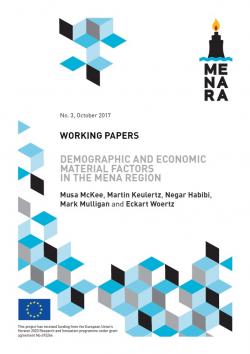Demographic and Economic Material Factors in the MENA Region
The Middle East and North Africa is one of the world’s most rapidly transforming regions, politically, economically, demographically and environmentally. Despite largely declining total fertility rates, the momentum of absolute population growth will mean that the region surpasses China in terms of total population by 2090. Land degradation, water stress and trends of urbanisation will also have significant impacts upon the future development of this region. In contending with the coming social, ecological and climatic shifts facing the region, policymakers will need to effectively capture the multi-faceted dynamics of these challenges but also opportunities. This paper outlines the key demographic and economic trends and transitions underway across MENA countries as material factors informing the efficacy of future policy responses to these emergent trends. Demographic trends in age-specific and gender ratios are discussed, before exploring transitions in fertility rates, migration, conflict, social welfare and urbanisation along with the possible implications of such transitions. Later, key economic factors are assessed, including correlations between resources endowments, labour market performance (particularly rates of youth unemployment), public debt and expenditure figures, and trade performance indicators. Considered together, a sub-regional disaggregation of these economic factors is presented, characterising emerging trends and challenges across the region and its broader integration into the global economy.
-
Details
Roma, IAI, October 2017, 42 p. -
In:
-
Issue
Working Papers 3
Introduction
1. Demographic Factors
1.1 Emerging Trends
1.1.1 Absolute Population Size
1.1.2 Gender Ratio
1.1.3 Age-Specific Ratios
1.2 Transition Analysis
1.2.1 Fertility Transitions
1.2.2 Migration and Conflict
1.2.3 Social Welfare and Inclusion
1.2.4 Urbanisation
Conclusions
2. Economic Factors
2.1 Regional Overview
2.1.1 Classification of Countries
2.1.2 Historical and Current GDP in the MENA Region
2.2 The MENA Labour Market
2.3 Government Debt in MENA Countries
2.4 Trade in MENA Countries
2.4.1 Export and Import Trends
Conclusions and Ways Forward
References
Annex



